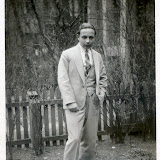Photographs by a Turkish Student in Berlin, 1929 - 1930
“I am a camera with its shutter open, quite passive, recording, not thinking …”
Christopher Isherwood. Goodbye to Berlin
Driven to be a writer, in the late 1920s Christopher Isherwood believed he had two options. One was to remove himself to a farmhouse and work in solitude. The other was to stand at the centre of the world from where he could study the chaos of its detritus furiously spinning around. That meant moving to Berlin, the city any intelligent observer at the time realized was where Europe’s fate was about to be determined.
Whether or not he was a capable analyst, Isherwood had one quality that would give his observations a vividness lacking among seasoned professionals. Throughout the two books that came from his stay, Goodbye to Berlin and Mr Norris Changes Trains, he comes across as a fish out of water, bemused and somewhat naïve. From this position, he learns things in Berlin others take for granted. Neither book explains what is unfolding as the Weimar Republic collapses but, in line with his famous quote about being a camera, he presents a series of tacit images. Isherwood began writing his ideas down in 1930. By the time the six pieces that make up Goodbye to Berlin were assembled into one, nine years later, war was just a breath away and the book had taken on a sibylline quality.
At exactly the same time as Isherwood was blithely moving between apartments and collecting his thoughts, a student from Turkey arrived in the city. He had a real camera, a Kodak or a Voigtlander with a folding bellows and a little ground glass window which allowed him to hold the instrument at waist height to compose his shots. If he was a good student, he understood he was there to observe.
The Turkish Republic was just seven years old and in the middle of its own cultural revolution. Ataturk was tearing down the remnants of the Ottoman Empire and assembling a modern, secular state. It’s quite likely the student was sent abroad with the idea that what he learned in Europe he would bring back to the new republic, that he was expected to be in the vanguard of modernism.
Whatever knowledge he brought back about law or science or the arts, his photographs, the only tangible remains of his experience, correspond with some of Isherwood’s sentiments. Isherwood, for example, never mentions modernist art, but it is clear from the way he structured his writing that he was aware he could say things in new ways. Whether or not student was aware of the Bauhaus before he arrived in Berlin, his photographs of the tower and the harbour and window scenes are not coincidences. He is playing with contemporary ideas.
The most apparent comparisons however are in their portraits. Isherwood ranged across a wide spectrum, from the inhabitants of cheap boarding houses to millionaires who never quite explained the source of their wealth, from the gay milieu to upright Jewish department store owners, with the developing theme that their ideas and lifestyles will damn them. A similar sense of doom infects the photographs. Maybe it’s because there is a whole set of images and everybody is expressively affectionate and happy but there is a poignancy to these photos that has everything to do with time and place. Beneath the smiles these people may have a sense of unease but we know for sure what will occur in a few years.
VIEW THE GALLERY HERE
 |
| GOODBYE TO BERLIN |




No comments:
Post a Comment
Add comments here